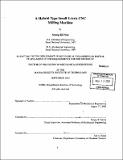| dc.contributor.advisor | Sanjay E. Sarma. | en_US |
| dc.contributor.author | Son, Seung-Kil, 1964- | en_US |
| dc.contributor.other | Massachusetts Institute of Technology. Dept. of Mechanical Engineering. | en_US |
| dc.date.accessioned | 2005-10-14T19:35:32Z | |
| dc.date.available | 2005-10-14T19:35:32Z | |
| dc.date.copyright | 2002 | en_US |
| dc.date.issued | 2002 | en_US |
| dc.identifier.uri | http://hdl.handle.net/1721.1/29275 | |
| dc.description | Thesis (Ph. D.)--Massachusetts Institute of Technology, Dept. of Mechanical Engineering, 2002. | en_US |
| dc.description | Includes bibliographical references (leaves 116-119). | en_US |
| dc.description.abstract | 5-axis CNC milling machines are important in a number of industries ranging from aerospace to consumer-die-mold machining because they can deliver high machining accuracy with a spindle tilting capacity. Most of these machines have serial mechanisms so that low static and dynamic stiffness become very critical design issues especially for high speed machining. Parallel mechanisms have recently received attention from machine tool designers because of their inherent potential for stiffness and because of their compactness. However, much of the promised advantages of parallel machines only occur within a very small region of their workspace with the expense of the large machine-tool foot print. We discuss some of the kinematic and structural challenges to extracting machining performance from serial and parallel machines. We compare a hybrid machine, which combines serial and parallel mechanisms, with typical serial and parallel machines such as Euler angle machines and the Hexapod. In particular, we consider singularities, reversal characteristics, and manufacturability. We show that hybrid machines can benefit from the advantages of serial and parallel mechanisms while avoiding most potential pitfalls of both mechanisms. However, hybrid structures can suffer from the manufacturing problem of over-constraint. We show that the degree of over-constraint depends on the size of the parallel machine. We have designed and fabricated a small hybrid 5-axis motion platform, the MIT-SS-1, which can tolerate this over-constraint through a novel layout of axes. Numerical and experimental test results of the MIT-SS-1 are presented and compared. Finally we show that this structure has potential as a small 5-axis CNC milling machine. | en_US |
| dc.description.statementofresponsibility | by Seung-Kil Son. | en_US |
| dc.format.extent | 128 leaves | en_US |
| dc.format.extent | 5355206 bytes | |
| dc.format.extent | 5355015 bytes | |
| dc.format.mimetype | application/pdf | |
| dc.format.mimetype | application/pdf | |
| dc.language.iso | eng | en_US |
| dc.publisher | Massachusetts Institute of Technology | en_US |
| dc.rights | M.I.T. theses are protected by copyright. They may be viewed from this source for any purpose, but reproduction or distribution in any format is prohibited without written permission. See provided URL for inquiries about permission. | en_US |
| dc.rights.uri | http://dspace.mit.edu/handle/1721.1/7582 | |
| dc.subject | Mechanical Engineering. | en_US |
| dc.title | A hybrid type small 5-axis CNC milling machine | en_US |
| dc.type | Thesis | en_US |
| dc.description.degree | Ph.D. | en_US |
| dc.contributor.department | Massachusetts Institute of Technology. Department of Mechanical Engineering | |
| dc.identifier.oclc | 52076629 | en_US |
